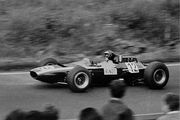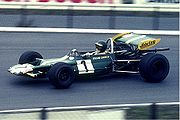Jochen Rindt
|
||||||||||||||||||||||||||||||||
|
||||||||||||||||||||||||||||||||
Karl Jochen Rindt (April 18, 1942 Mainz, Germany - September 5, 1970 Monza, Italy) was a German racing driver who represented Austria over his entire career.[2] He is the only driver to posthumously win the Formula One World Drivers' Championship (in 1970), after being killed in practice for the Italian Grand Prix. Away from Formula One, Rindt was highly successful in other single-seater formulae, as well as sports car racing. In 1965 he won the 24 Hours of Le Mans race, driving a Ferrari 250LM in partnership with Masten Gregory from the United States of America.
Contents |
Biography




Jochen Rindt was born in Mainz, Germany, but after his parents were killed in a bombing raid in Hamburg during the Second World War[3], he was raised by his grandparents in Graz, Austria, where he grew up and started motor racing. Although Rindt never became an Austrian citizen, he did drive his entire career under an Austrian racing licence.[4]
Despite being very successful in Formula 2 (by winning for instance the 1964 London Trophy), Rindt kept on choosing the wrong F1 cars. Rindt made his Formula One debut for the Rob Walker Racing Team in the 1964 Austrian Grand Prix. It was to be his only Grand Prix of the year. From 1965 to 1967, Rindt raced for the Cooper Car Company, scoring 32 points in 29 races. In 1968, Rindt raced for Brabham, but his season wasn't what he had hoped for due to technical problems. He also raced in the Indianapolis 500 in both 1967 and 1968, but finished no better than 24th.
Rindt was noted for being an exceptionally fast driver with superb car control and reflexes, but rarely had a car equal of his talent until 1969 when Rindt moved to Lotus and it was with Lotus that Rindt's career took off. Rindt clinched the first Grand Prix victory of his career in the 1969 Grand Prix of the USA in Watkins Glen. Rindt finished that year with 22 points, giving him fourth place in the Formula 1 World Championship. Rindt occasionally had a fraught relationship with Colin Chapman as he preferred a stable technological footing as opposed to Chapman's need to innovate and invent, but the two forged a successful partnership. Rindt's first victory in the 1970 season was at Monaco, where he overtook Jack Brabham in the last corner. Thereafter armed with perhaps the greatest Formula one car of all time, the Lotus 72, Rindt won four more Grands Prix in The Netherlands, France, Britain and Germany that year.
During practice for the 1970 Italian Grand Prix in Monza, near Milan, Chapman and Rindt agreed to follow the lead of Jackie Stewart (Tyrrell) and Denny Hulme (McLaren) and run without wings in an attempt to reduce drag and gain a higher top speed. The more powerful Flat-12 Ferraris of Jacky Ickx and Clay Regazzoni had been up to 10 mph (16 km/h) faster than the Lotus at the previous race in Austria. Rindt's team mate John Miles was unhappy with the wingless setup in Friday practice, reporting that the car 'wouldn't run straight'. Rindt reported no such problems, and Chapman recalled that Rindt reported the car to be 'almost 800 rpm faster on the straight' without wings.[5]
On the following day, Rindt ran with higher gear ratios fitted to his car to take advantage of the reduced drag, increasing the cars' potential top speed to 205 mph (330 km/h).[6] On Rindt's fifth lap of the final practice session, Hulme, who was following, reported that under braking for the Parabolica corner: 'Jochen's car weaved slightly and then swerved sharp left into the crash barrier.'[7] A joint in the crash barrier parted, the suspension dug in under the barrier and the car hit a stanchion head on. The front end of the car was destroyed. Although Rindt was rushed to hospital, he was pronounced dead. Rindt had only recently acquiesced to wearing a simple lap belt, and had slid underneath where the belt buckle cut his throat. He was the second Lotus team leader to be killed in two years, as Jim Clark had been killed in 1968 in a Formula 2 race at Hockenheim. An Italian court later found that the accident was initiated by a failure of the car's right front brakeshaft, but that Rindt's death was caused by poorly installed crash barriers.[8]
Rindt is buried at the central cemetery (Zentralfriedhof) in Graz.
At the time he died Rindt had won five of that year's ten Grands Prix, which meant that he had a strong lead in the World Championship. At that stage he theoretically could have been overtaken by Ferrari driver Jacky Ickx. However Rindt's Lotus team mate, Emerson Fittipaldi, won the penultimate Grand Prix of the year at Watkins Glen, depriving Ickx of the points he needed to win the title, and so Rindt became motor racing's first posthumous World Champion. The trophy was presented to his Finnish widow Nina Rindt nee Lincoln, daughter of famous Finnish racer, Curt Lincoln. In a tragic twist of irony, it was learned that Jochen had already promised Nina he would retire from F1 if he won the world championship.
Complete World Championship Formula One results
(key) (Races in bold indicate pole position; races in italics indicate fastest lap)
| Year | Entrant | Chassis | Engine | 1 | 2 | 3 | 4 | 5 | 6 | 7 | 8 | 9 | 10 | 11 | 12 | 13 | WDC | Points[1] |
|---|---|---|---|---|---|---|---|---|---|---|---|---|---|---|---|---|---|---|
| 1964 | Rob Walker Racing Team | Brabham BT11 | BRM V8 | MON |
NED |
BEL |
FRA |
GBR |
GER |
AUT Ret |
ITA |
USA |
MEX |
NC | 0 | |||
| 1965 | Cooper Car Company | Cooper T73 | Climax V8 | RSA Ret |
13th | 4 | ||||||||||||
| Cooper T77 | Climax V8 | MON DNQ |
BEL 11 |
FRA Ret |
GBR 14 |
NED Ret |
GER 4 |
ITA 8 |
USA 6 |
MEX Ret |
||||||||
| 1966 | Cooper Car Company | Cooper T81 | Maserati V12 | MON Ret |
BEL 2 |
FRA 4 |
GBR 5 |
NED Ret |
GER 3 |
ITA 4 |
USA 2 |
MEX Ret |
3rd | 22 (24) | ||||
| 1967 | Cooper Car Company | Cooper T81 | Maserati V12 | RSA Ret |
MON Ret |
CAN Ret |
13th | 6 | ||||||||||
| Cooper T81B | Maserati V12 | NED Ret |
BEL 4 |
FRA Ret |
USA Ret |
MEX |
||||||||||||
| Cooper T86 | Maserati V12 | GBR Ret |
GER Ret |
ITA 4 |
||||||||||||||
| 1968 | Brabham Racing Organisation | Brabham BT24 | Repco V8 | RSA 3 |
ESP Ret |
MON Ret |
12th | 8 | ||||||||||
| Brabham BT26 | Repco V8 | BEL Ret |
NED Ret |
FRA Ret |
GBR Ret |
GER 3 |
ITA Ret |
CAN Ret |
USA Ret |
MEX Ret |
||||||||
| 1969 | Gold Leaf Team Lotus | Lotus 49B | Ford V8 | RSA Ret |
ESP Ret |
MON |
NED Ret |
FRA Ret |
GBR 4 |
GER Ret |
ITA 2 |
CAN 3 |
USA 1 |
MEX Ret |
4th | 22 | ||
| 1970 | Gold Leaf Team Lotus | Lotus 49C | Ford V8 | RSA 13 |
MON 1 |
BEL Ret |
1st | 45 | ||||||||||
| Lotus 72 | Ford V8 | ESP Ret |
||||||||||||||||
| Lotus 72C | Ford V8 | NED 1 |
FRA 1 |
GBR 1 |
GER 1 |
AUT Ret |
ITA DNS |
CAN |
USA |
MEX |
Notes
- ↑ 1.0 1.1 Up until 1990, not all points scored by a driver contributed to their final World Championship tally (see list of pointscoring systems for more information). Numbers without parentheses are Championship points; numbers in parentheses are total points scored.
- ↑ Aeiou Encyclopedia: "Rindt, Jochen"
- ↑ Nur auf der Rennstrecke sterblich
- ↑ Mappes-Niediek (2008) p. 35
- ↑ Prüller (1970) pp.192—193
- ↑ Prüller (1970) p.195
- ↑ Prüller (1970) p.199
- ↑ Nye (1986) p.69
References
- Nye, Doug (1986). Autocourse history of the Grand Prix car 1966–85. Hazleton publishing. ISBN 0-905138-37-6.
- Prüller, Heinz (1970). Jochen Rindt. Kimber Publishing. SBN 7183-0162-5.
- Mappes-Niediek, Norbert (2008). Österreich für Deutsche: Einblicke in ein fremdes Land. Links Verlag. ISBN 978-3-86153-454-9.
External links
- Grand Prix History - Hall of Fame, Jochen Rindt
- Jochen Rindt statistics
| Sporting positions | ||
|---|---|---|
| Preceded by Jean Guichet Nino Vaccarella |
Winner of the 24 Hours of Le Mans 1965 with: Masten Gregory |
Succeeded by Bruce McLaren Chris Amon |
| Preceded by Jackie Stewart |
Formula One World Champion 1970 |
Succeeded by Jackie Stewart |
| Preceded by Piers Courage |
Formula One fatal accidents September 5, 1970 |
Succeeded by Jo Siffert |
|
|||||||||||||
|
|||||||||||||||||||||||
